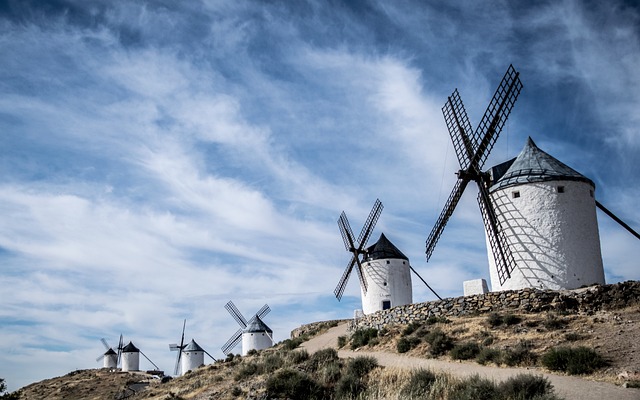|
MOLINOS
|
| Gracias a: javierAlamo |
|
Text 1: The image shows a line of old-fashioned windmills on a wide, open plain. These windmills have tall, slender wooden structures with large blades that stretch high into the sky. The windmills are made of dark brown wood, and their blades are painted in a white and blue pattern. They are spaced out across a flat, grassy field with a few patches of trees in the distance. The sky above them is mostly clear, with just a few clouds dotting the horizon. The windmills seem to be inactive, with the blades resting still in the light breeze. The area around them looks quite serene, as the ground is flat, and there seems to be no elevation, suggesting that the windmills were built for ease of access and maintenance. These windmills likely served to grind grain or pump water in earlier times, though now they appear to be standing as historical relics. Text 2: The image shows a series of traditional windmills standing on a rugged, hilly terrain. The windmills are constructed from stone and have distinctive white cylindrical towers with cone-shaped roofs. Their large, black blades are spread wide, catching the wind on a bright, partly cloudy day. These windmills are perched on a hillside, overlooking a dirt path that winds through dry, scrubby vegetation. The scene suggests a rural, almost isolated setting where the windmills would have once played a vital role in milling grain for the local community. Though they are no longer in use, they remain a prominent feature of the landscape, standing tall against the vibrant sky. Text 3: The image depicts a row of windmills lined up along a flat expanse of land. Each windmill is characterized by a white base with a cylindrical structure, topped with a black, domed roof. Their blades, made of a light brown wood, appear to be in motion, turning with the breeze. The windmills are evenly spaced and are connected by a narrow dirt road that runs in front of them. The surroundings are grassy and lush, with small bushes dotting the landscape. The sky above is clear, with no clouds, and the sun shines brightly, illuminating the entire scene. These windmills are clearly part of a peaceful rural area, where they would have been used for centuries to harness wind power for agricultural purposes.
Windmill – Molino de viento: Estructura utilizada para aprovechar la energía eólica para moler granos o bombear agua, tradicionalmente construida con una torre y aspas o palas que giran con el viento. Blade – Aspa: Parte giratoria de un molino de viento que atrapa el viento y genera el movimiento necesario para su funcionamiento. Cylindrical – Cilíndrico: Forma geométrica con un cuerpo circular alargado, común en la base de muchos molinos tradicionales. Cone-shaped – En forma de cono: Estructura que tiene una base circular que se estrecha hacia la parte superior, como los techos de algunos molinos. Rugged – Escarpado: Terreno irregular y rocoso, a menudo montañoso o con colinas, como el entorno de los molinos en la imagen. Hilly – Colinas: Terreno con muchas colinas o elevaciones suaves, a menudo encontrado en áreas rurales donde se ubican los molinos. Stone – Piedra: Material comúnmente usado en la construcción de molinos antiguos, como las torres de los molinos de la imagen. Scrubby vegetation – Vegetación arbustiva: Plantas bajas y resistentes, típicas de áreas secas o áridas, como las que rodean los molinos. Dirt path – Camino de tierra: Senda o camino sin pavimentar, frecuentemente encontrado en áreas rurales o naturales, como el que aparece en la imagen. Partly cloudy – Parcialmente nublado: Estado del cielo cuando hay nubes dispersas, dejando ver parcialmente el sol, como se observa en la imagen. Inactive – Inactivo: No en funcionamiento. Se refiere a los molinos que ya no se utilizan para sus fines originales. Historical relic – Reliquia histórica: Objeto o estructura de tiempos pasados que se mantiene como testimonio de la historia, como los molinos que ya no están en uso. Grain milling – Molienda de granos: Proceso de convertir el grano en harina, una función principal de los molinos de viento en su época activa. Agricultural purposes – Fines agrícolas: Usos relacionados con la agricultura, como el papel de los molinos en la producción de alimentos. Wind power – Energía eólica: Energía generada por el viento, utilizada históricamente para mover las aspas de los molinos y generar energía mecánica para la molienda o el bombeo. |





